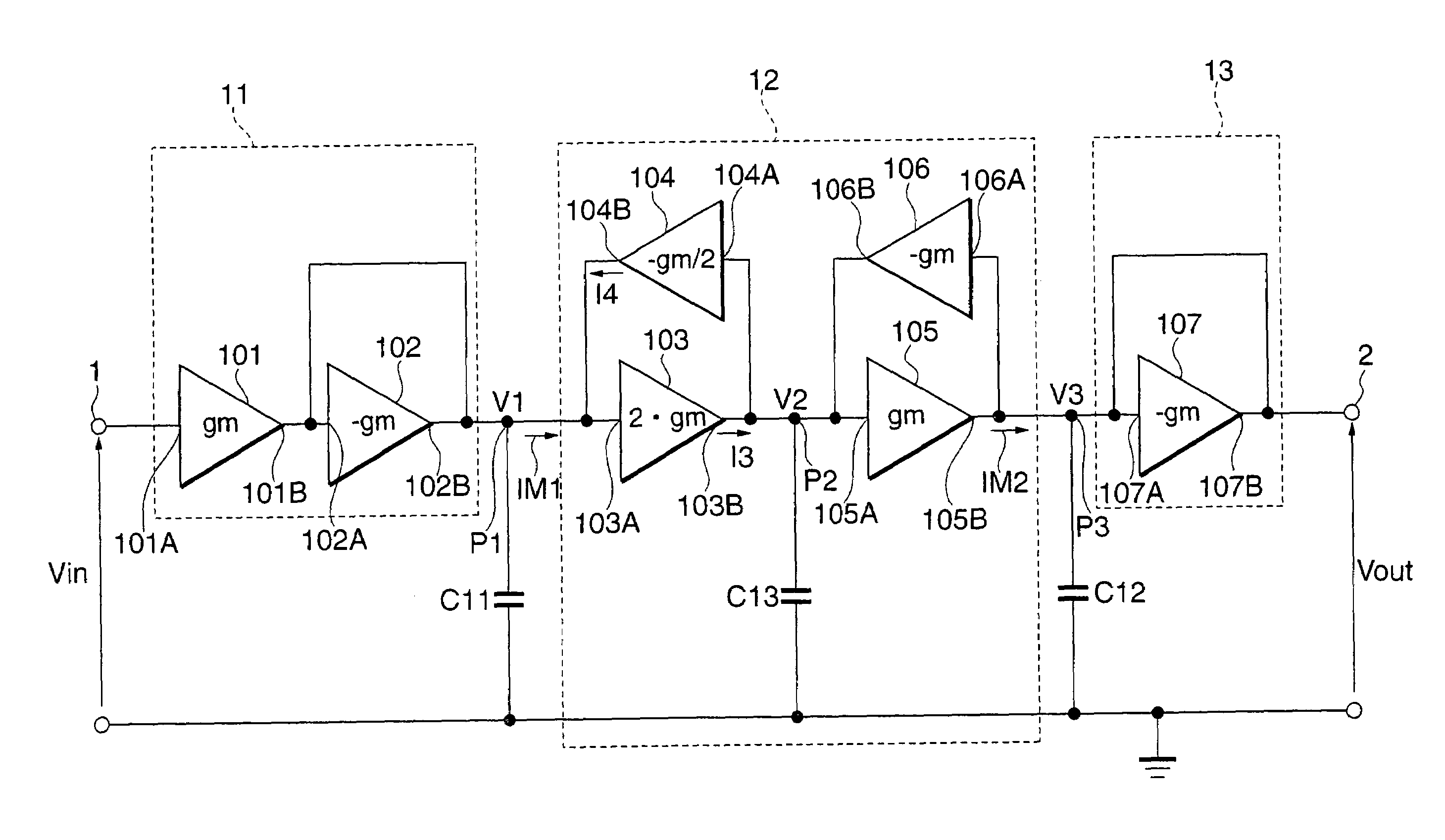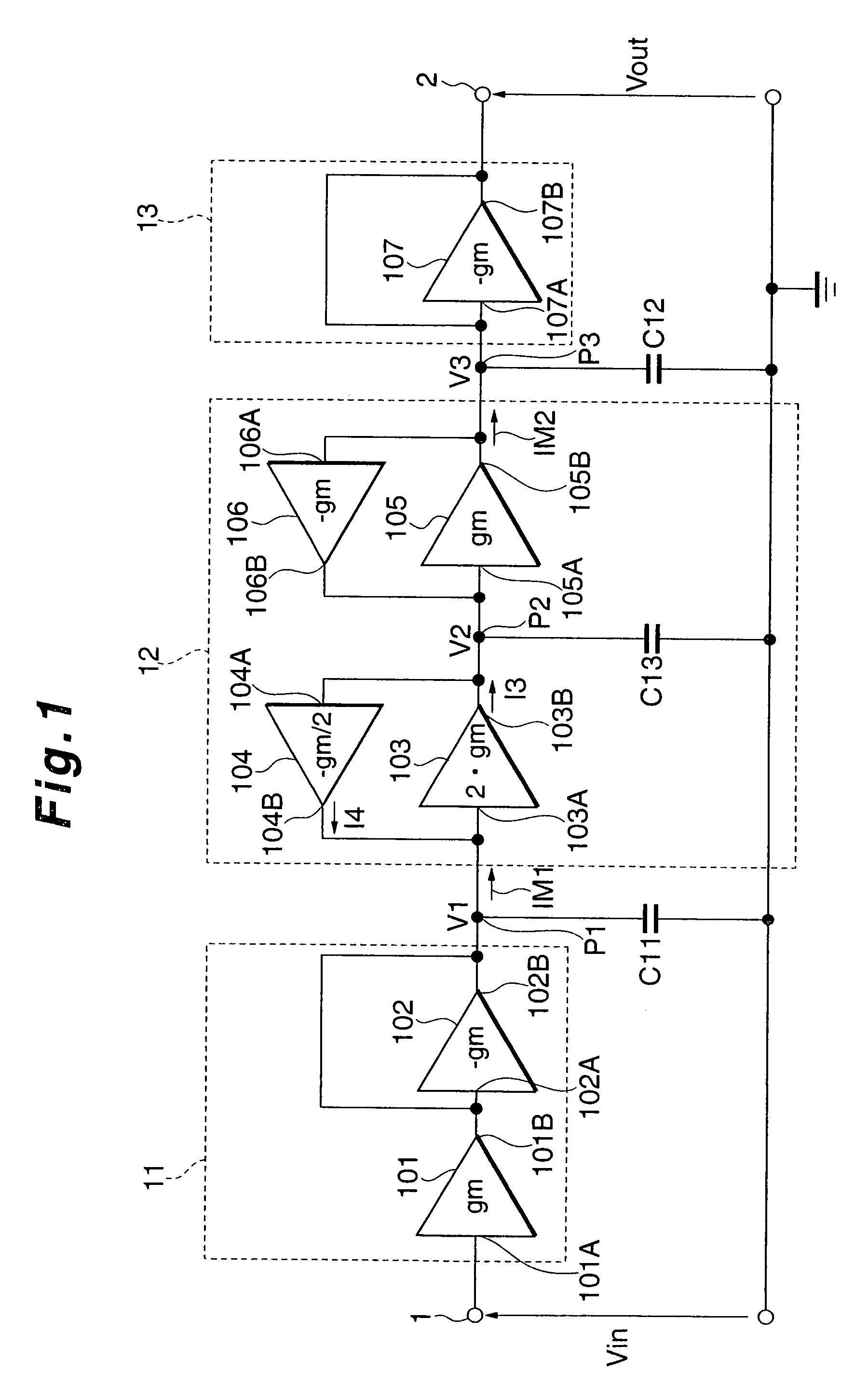Active filter circuit with reduced noise
a filter circuit and active technology, applied in the field of filter circuits, can solve the problems of inability to adjust the variations in temperature characteristics and device values, and the voltage controlled current source itself can become a main noise source, and achieve the effect of reducing the noise of input conversion
- Summary
- Abstract
- Description
- Claims
- Application Information
AI Technical Summary
Benefits of technology
Problems solved by technology
Method used
Image
Examples
second embodiment
(B) Second Embodiment
[0094]Only different points between the first and second embodiments will now be described hereinbelow.
[0095]The second embodiment will be also explained with respect to a filter circuit of the LC ladder type of the ternary π type as an example.
(B-1) Construction of the Second Embodiment
[0096]FIG. 2 shows the filter circuit of the second embodiment.
[0097]In FIG. 2, the filter circuit has the input terminal 1, the output terminal 2, an input terminating portion 21, an inductor portion 22, and an output terminating portion 23.
[0098]Voltage controlled current sources 201 to 207 constructing the portions 21 to 23 are provided in the filter circuit. Mutual conductances of the voltage controlled current sources 201 to 207 are set as follows. That is, the current sources 201 and 203 are set to gm, the current source 202 is set to −gm, the current source 205 is set to gm / 2, and the current sources 204, 206, and 207 are set to −gm / 2, respectively.
[0099]The input terminal...
third embodiment
(C) Third Embodiment
[0115]Only different points between the first embodiment and the third embodiment will be described hereinbelow.
[0116]Although the first embodiment has been described with respect to the filter circuit of the LC ladder type of the ternary π type, the third embodiment relates to a low pass filter circuit of the resistance both-terminating LC ladder type of the quinary π type.
(C-1) Construction of the Third Embodiment
[0117]FIG. 3 shows the filter circuit of the third embodiment.
[0118]In FIG. 3, the filter circuit has the input terminal 1, the output terminal 2, eleven voltage controlled current sources 301 to 311, and five capacitors C31 to C35.
[0119]Mutual conductances of the voltage controlled current sources 301 to 311 are set as follows. That is, the current sources 301, 303, 305, and 309 are set to gm, the current sources 302, 304, 306, 310, and 311 are set to −gm, the current source 307 is set to 5≅gm, and the current source 308 is set to −gm / 5, respectively....
fourth embodiment
(D) Fourth Embodiment
[0138]Only different points between the first and second embodiments and the fourth embodiment will now be described hereinbelow.
[0139]The fourth embodiment relates to a modification of the filter circuit 70.
(D-1) Construction and Operation of the Fourth Embodiment
[0140]FIG. 12 shows a filter circuit in the fourth embodiment.
[0141]In FIG. 12, the filter circuit has the input terminal 1, the output terminal 2, the input terminating portion 11, an intermediate circuit portion 80, and the output terminating portion 23.
[0142]Among them, the functions of the component elements designated by the same reference numerals as 1, 2, 11, and 23 in the first and second embodiments are substantially the same as those of the corresponding component elements in the first and second embodiments.
[0143]Therefore, the fourth embodiment is characterized by the intermediate circuit portion 80.
[0144]The intermediate circuit portion 80 has the voltage controlled current sources 103, 10...
PUM
 Login to View More
Login to View More Abstract
Description
Claims
Application Information
 Login to View More
Login to View More - R&D
- Intellectual Property
- Life Sciences
- Materials
- Tech Scout
- Unparalleled Data Quality
- Higher Quality Content
- 60% Fewer Hallucinations
Browse by: Latest US Patents, China's latest patents, Technical Efficacy Thesaurus, Application Domain, Technology Topic, Popular Technical Reports.
© 2025 PatSnap. All rights reserved.Legal|Privacy policy|Modern Slavery Act Transparency Statement|Sitemap|About US| Contact US: help@patsnap.com



